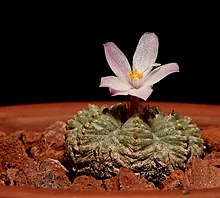The genus Aztekium contains two species of small globular cactus. Discovered in 1929 by F. Ritter, in Rayones, Nuevo León, Mexico, this genus was thought to be monotypic (with Aztekium ritteri) until a second species (Aztekium hintonii) was discovered by George S. Hinton, in Galeana, Nuevo León in 1991. A further possible species, Aztekium valdezii, was described in 2011, but is considered to be a synonym of A. ritteri.[3]
| Aztekium | |
|---|---|

| |
| Aztekium ritteri | |
| Scientific classification | |
| Kingdom: | Plantae |
| Clade: | Tracheophytes |
| Clade: | Angiosperms |
| Clade: | Eudicots |
| Order: | Caryophyllales |
| Family: | Cactaceae |
| Subfamily: | Cactoideae |
| Tribe: | Cacteae |
| Genus: | Aztekium Boed.[1] |
| Species | |
| |
Description edit
Aztekium ritteri is a small plant (around 20 mm wide), with 9 to 11 ribs, which typically have transverse wrinkles. Its color varies from pale green to grayish-green. The center of the cactus contains a lot of white wool. Flowers are small (less than 10 mm wide), with white petals and pinkish sepals. The plants bear small pinkish berry-like fruits. A. hintonii is larger, to 10 cm in diameter, 10 to 18 grooved ribs, flowers magenta to 3 cm. It grows only on gypsum.
Species edit
| Image | Scientific name | Distribution |
|---|---|---|
| Aztekium hintonii | Nuevo León | |
| Aztekium ritteri | Mexico |
Etymology edit
Its name is dedicated to the Aztec people, due to the resemblance between the plant's shape and certain Aztec sculptures.[citation needed]
Distribution edit
This genus is found only in the state of Nuevo León in Mexico. It was estimated[by whom?] that there were in the order of tens of millions of plants of A. hintonii, and at present most of its range is pristine.[citation needed] Though A. ritteri has been collected for decades and there has been destruction of its habitat, the number of plants in habitat is several million.[citation needed]
Cultivation edit
These species grow extremely slowly, taking around two years to attain a diameter of 3 mm. They are usually propagated by seeds.[citation needed]
Phytochemistry edit
The plants contain the following compounds[citation needed]:
References edit
- ^ "Genus: Aztekium Boed". Germplasm Resources Information Network. United States Department of Agriculture. 2012-04-16. Retrieved 2012-07-31.
- ^ "GRIN Species Records of Aztekium". Germplasm Resources Information Network. United States Department of Agriculture. Retrieved 2012-07-31.
- ^ "Aztekium valdezii Velazco, M.A.Alvarado & S.Arias". Plants of the World Online. Royal Botanic Gardens, Kew. Retrieved 2019-08-01.
External links edit
Media related to Aztekium at Wikimedia Commons Data related to Aztekium at Wikispecies